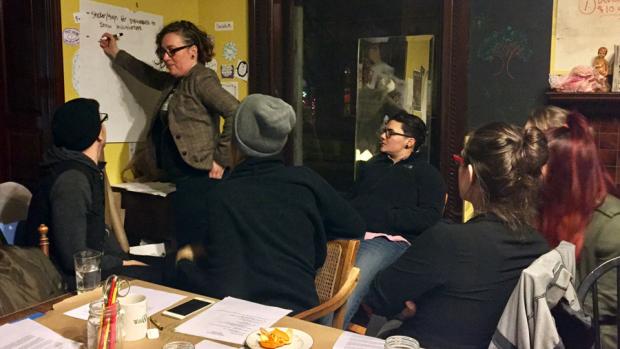Hate Crime: Real and False Solutions
On a sweltering hot evening in August of last year, 30-some people crammed into my apartment for the first official meeting of Queers for Racial Justice, a group dedicated to an intersectional movement grounded in the belief that everyone should be able to live out their truth without fear of retaliation and that we each hold diverse identities.
At that meeting I first shared publicly an incident that occurred many years ago, when I first moved back to Buffalo, that explained why I thought it was necessary to co-found such an organization.
Many in the room had known me for years and others for mere moments. As I stood in the front of the room, I leaned my back against the fireplace for support. I told the story of my then girlfriend and I being verbally harassed by a man for being queer. I didn’t repeat what he said, though his words have never left me. We were trying our best not to engage as he followed us across the street and shouted derogatory terms at us. He eventually would punch us both and threaten to pull a knife. For what? For existing, I suppose.
Although this was difficult to stomach, I think it is the events immediately after that continue to haunt me.
This was at the height of what elected officials and even most residents deemed the comeback of Buffalo. Talk of the renaissance could be heard from sunup to sundown, and anyone that said otherwise quickly found themselves marginalized to some degree.
I reported the incident to friends and acquaintances at a bar after tears began to stream down my face unexpectedly. There were some who listened and wanted to report the assault to the authorities and to the media. And then there were others who thought it best for Buffalo if we stayed silent and let the narrative of the resurgence fill the void. Eventually we settled on calling on a police officer whom someone knew and who could handle the matter discreetly. Twenty minutes later, we were whisked away in his squad car back to Allen Street. I sat in the front with the officer, while Alix sat in the back. The officer drove slowly and asked us if there was anyone that looked like the man who had assaulted us. We said no. He proceeded to ask us the same question each time a black man was in sight. We continued to say no. Alix and I exchanged glances, increasingly uneasy at the officer’s willingness to suggest that any one of these men would do. All we had to do was say the word. It became more explicit as time progressed, and that is when Alix and I insisted that we be taken back.
It’s the reason that the most recent hate crime in Allentown has hit so close to home for me, and it’s also the reason why it’s important to not let it go this time. For every person who comes forward, there are countless others who don’t for one reason or another.
Queers for Racial Justice has continued to call for community-based solutions instead of an increased police presence in the Allentown neighborhood. As members of the LGBTQ community, we support the safety and well-being our community and all Buffalonians. We do not, however, believe that an increased police presence or that cooperation with the Buffalo Police Department will ultimately lead to increased security for queer and trans people, particularly low-income and queer and trans people of color, whose communities are already over-policed.
We also know that white privilege creates dynamics like the one I experienced so many years ago. The social construct of whiteness has made some lives more valuable than others, even amongst historically marginalized communities. It has also perpetuated a dangerous and overtly racist stereotype about black boys and men. In the February 18 assault, the young men of color were referred to as “thugs” and said to be part of a “gang.” This only adds to implicit bias and gives poorly trained police officers the ammunition needed to turn a bad situation into a more hostile, or violent, or even deadly one.
We don’t need false solutions, we need real security.
For that reason, Queers for Racial Justice is committed to facilitating a series of community meetings to strategize different ways that members of the LGBTQ community can heal and move forward from here. The first of such meetings was held in late February at Nickel City Coop’s Ol’ Wondermoth, which serves as a hub for the Allentown neighborhood. Mike Slater and Pat, the two survivors of the attack, had the chance to speak for themselves, and those gathered were given the space to process how they were feeling and their own personal experiences. It also resulted in a long list of tactics.
There were elders in the movement present who were without a doubt comrades of the late writer and activist Leslie Feinberg. They talked about how the Rainbow Peacekeepers, a community patrol that was developed by Carol Speser and others, provided a strong, unified presence in the LGBTQ community and in the good work of clinic defense.
Other proposals centered around outreach to businesses in Allentown, increased visibility through posters and signage, collaboration with various LGBTQ organizations that offer self-defense trainings and classes, the creation of a network of safe spaces, and, lastly, the continued need to build an intersectional movement through solidarity with similarly impacted communities. Personally, I also have a great desire to see restorative justice practices become a standard response in dealing with such events. The establishment of hubs in connection with the network safe spaces could begin conversations between two seemingly disparate groups of people who have a common self-interest: dismantling white supremacy.
The next community meeting will be held next Thursday, March 16, 7pm, at Ol’ Wondermoth (208 North Street). For more information on Queers for Racial Justice, follow us on Facebook.

